The crazy-paving pattern: a radiological-pathological correlation
- PMID: 22347941
- PMCID: PMC3259383
- DOI: 10.1007/s13244-010-0060-5
The crazy-paving pattern: a radiological-pathological correlation
Abstract
The crazy-paving pattern is a linear pattern superimposed on a background of ground-glass opacity, resembling irregularly shaped paving stones. The crazy-paving pattern is initially described as the pathognomonic sign of alveolar proteinosis. Nowadays this pattern is a common finding on high-resolution CT imaging, and can be seen in a number of acute and chronic diseases. The purpose of this paper is to illustrate different diseases that cause this crazy-paving pattern and to correlate the radiological findings from computed tomography with the histopathological findings.
Figures
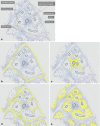

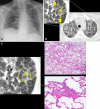
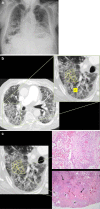
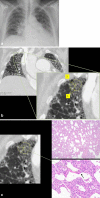
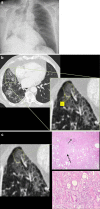
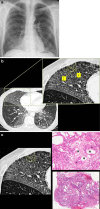








Similar articles
-
Lung adenocarcinoma with mixed solid and crazy-paving appearances.Clin Case Rep. 2021 Oct 4;9(10):e04847. doi: 10.1002/ccr3.4847. eCollection 2021 Oct. Clin Case Rep. 2021. PMID: 34631066 Free PMC article.
-
The Clinical Significance of a 'Crazy-Paving' Pattern on Chest Radiology.Eur J Case Rep Intern Med. 2018 Dec 27;5(12):000978. doi: 10.12890/2018_000978. eCollection 2018. Eur J Case Rep Intern Med. 2018. PMID: 30755996 Free PMC article.
-
A rare cause of crazy-paving and mediastinal lymphadenopathy: congestive heart failure.J Clin Imaging Sci. 2013 Jul 29;3:30. doi: 10.4103/2156-7514.115762. eCollection 2013. J Clin Imaging Sci. 2013. PMID: 24083067 Free PMC article.
-
["Crazy paving" of the lungs].Praxis (Bern 1994). 2014 Mar 26;103(7):385-9. doi: 10.1024/1661-8157/a001606. Praxis (Bern 1994). 2014. PMID: 24686759 Review. German.
-
"Crazy-paving" pattern at thin-section CT of the lungs: radiologic-pathologic overview.Radiographics. 2003 Nov-Dec;23(6):1509-19. doi: 10.1148/rg.236035101. Radiographics. 2003. PMID: 14615561 Review.
Cited by
-
"Crazy-paving" pattern: A characteristic presentation of pulmonary alveolar proteinosis and a review of the literature from India.Lung India. 2016 May-Jun;33(3):335-42. doi: 10.4103/0970-2113.180936. Lung India. 2016. PMID: 27186004 Free PMC article. No abstract available.
-
Validation of Diagnostic Accuracy and Disease Severity Correlation of Chest Computed Tomography Severity Scores in Patients with COVID-19 Pneumonia.Diagnostics (Basel). 2024 Jan 8;14(2):148. doi: 10.3390/diagnostics14020148. Diagnostics (Basel). 2024. PMID: 38248025 Free PMC article.
-
Eight pruning deep learning models for low storage and high-speed COVID-19 computed tomography lung segmentation and heatmap-based lesion localization: A multicenter study using COVLIAS 2.0.Comput Biol Med. 2022 Jul;146:105571. doi: 10.1016/j.compbiomed.2022.105571. Epub 2022 May 21. Comput Biol Med. 2022. PMID: 35751196 Free PMC article.
-
A case of pulmonary infection with Prevotella melanogenica having the paving stone symptom.J Radiol Case Rep. 2023 Mar 1;17(3):1-7. doi: 10.3941/jrcr.v17i3.4420. eCollection 2023 Mar. J Radiol Case Rep. 2023. PMID: 37021294 Free PMC article.
-
Diffuse Alveolar Hemorrhage Due to Malignant Arterial Hypertension - an Unusual Manifestation of a Common Disease.J Belg Soc Radiol. 2016 Feb 19;100(1):38. doi: 10.5334/jbr-btr.959. J Belg Soc Radiol. 2016. PMID: 30151450 Free PMC article.
References
-
- Verschakelen JA, Wever W. Computed tomography of the lung. A pattern approach. Heidelberg: Springer; 2007.
LinkOut - more resources
Full Text Sources
